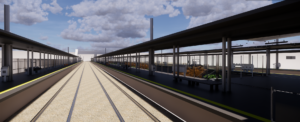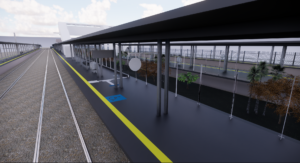
Since 2014, CPTM (Companhia Paulista de Trens Metropolitanos) is committed to researching new technologies that can prepare, adapt, and bring more innovation to the company’s internal and external processes. Because these were complex projects, it was necessary to choose a combination of solutions and methodologies that considered all perspectives. As such, they opted for the application of BIM (Building Information Modeling), which is a methodology that involves hardware, software and professionals to generate detailed three-dimensional models to reduce wasted time and even investment in the works.
In the design phase, BIM technology enabled the design of a project built on a parameterized model, which allows visualizing volume, estimating costs, quantifying and qualifying the applied materials, observing and adjusting environmental issues and other project items. The software package used in this process includes Autodesk Infrastructure solutions.

CPTM internally created a BIM core with 60 dedicated specialists who could begin to articulate the methodology, review standards and possible impacts. Throughout the development of the five accessibility adaptation projects, internally developed stations between 2016 and 2017, the teams involved in the project gained experience and were able to apply in practice the concepts learned in earlier stages of training and pilot projects.
These five projects resulted in the first work contracts from projects developed entirely within the BIM Process in the company, and companies contracted to carry out the activities will have to update the model provided in what is being called “As-Built in BIM.”
The works of the Ribeirão Pires, Rio Grande da Serra and Mogi das Cruzes stations have already been completed, and those of the Jaraguá station started at the end of February. The works for the Várzea Paulista station are being contracted.
“The BIM project has optimized our time spent at least 30% of the time. In addition, we do not need to go to the field as often to make and redo measures, traces and redirect people’s movement. What used to take about one month, now takes one to two days and is more efficient, since we can provision several scenarios, “said Eduardo Tavares, Project Manager at CPTM.
BIM for transportation infrastructure is a growing reality within the field of project development and construction. The main benefits include agility, efficiency, quality and cost reduction, which is critical in large, costly projects.
The modeling of the first stage may also serve as a basis for other projects. With mapping complete, it’s possible to make new studies to analyze areas, impacts, vacancies, etc.
“BIM allows decision making and study to be more accurate. And accordingly it’s possible to reduce costs, since the solution can anticipate possible failures and avoid unnecessary work, as well as evaluate the compatibility of projects with the deployment plan,” added Pedro Soethe, technical specialist in Architecture, Engineering and Construction of Autodesk in Brazil.
The next step of CPTM is to use BIM to monitor the works. For this, some members of the work teams have already been trained over the past year.
“We are paving the way to introduce BIM to the operational and asset management areas in the near future,” concluded Eduardo.
BIM Library
In addition to the development of the aforementioned project, it is important to highlight actions that have been taking place in parallel, and which are the basis for the BIM process to advance as a whole within the company. One item that deserves attention is an action currently under way, which is to review existing items and model new items in the BTM CPTM Library.
The first stage of the work involves the modeling and revision of approximately 500 items of Standard Architecture Projects, which will already be classified with their respective cost codes in the CPTM system and with design information.
This action aims to organize and catalog the Standard Projects and internal components to guarantee the reliability of these elements in the projects, and indirectly ends up growing the market, since the idea is also to make the library available to the designers, encouraging the realization of projects in the BIM platform.
In addition to the BIM elements themselves, the use of each of these items and respective technical documentation is being developed to facilitate the use of these objects in design by those who do not have advanced knowledge of modeling software.
In addition to the previous actions, the BIM CPTM Portal is being developed, which will act as a tool for disseminating knowledge in the company for matters related to BIM and will house the entire database of documents already produced(procedures / manuals, specifications techniques, handouts and material for participation in congresses and seminars), and to make available the items of the Library of BIM elements listed above.